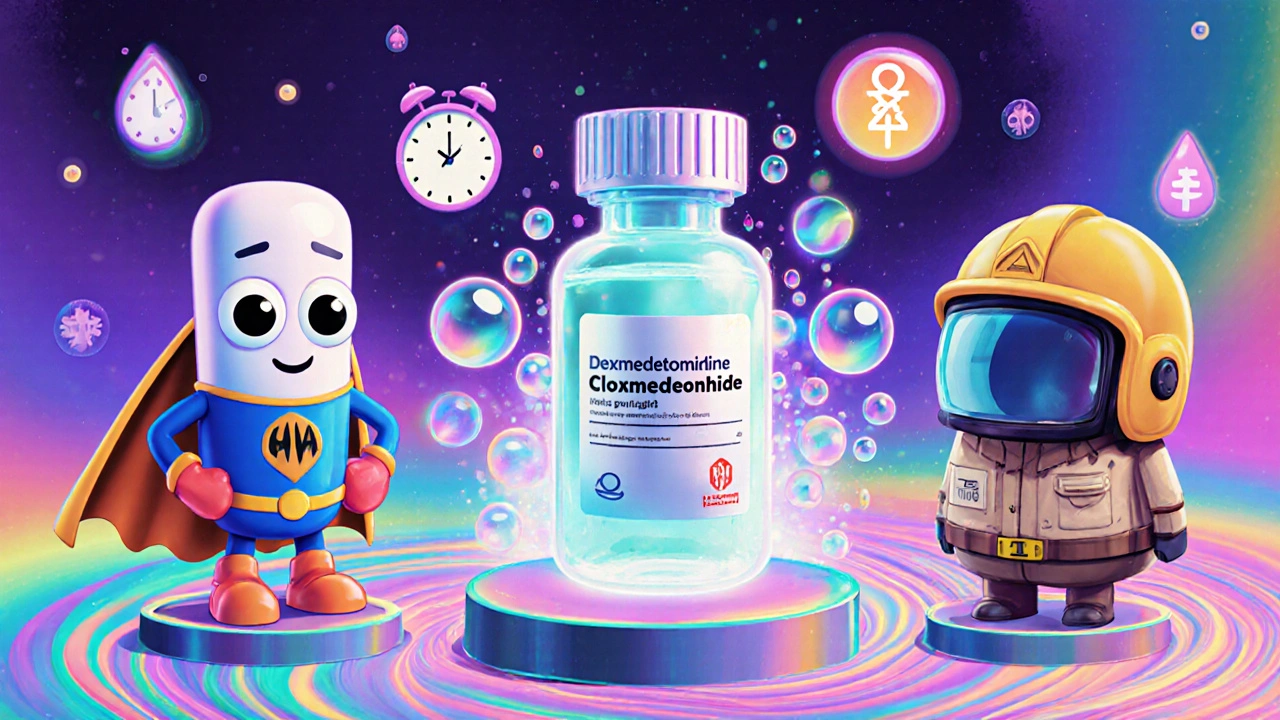Clonidine Alternative Selector
Select Your Scenario
When doctors need to tame stubborn high blood pressure or manage ADHD symptoms, Clonidine is often on the shortlist. But it’s not the only player in the game. Below you’ll find a side‑by‑side look at the most common alternatives, practical tips for picking the right one, and a quick checklist to keep you on track.
What is Clonidine?
Clonidine is a prescription medication that belongs to the alpha‑2 adrenergic agonist class. First approved in the 1970s, it works by reducing sympathetic outflow from the brain, which lowers heart rate and dilates blood vessels.
How Clonidine Works
By stimulating alpha‑2 receptors in the central nervous system, clonidine dampens the release of norepinephrine. The result is a drop in peripheral vascular resistance and, for many patients, a smoother blood‑pressure curve. The same mechanism also tweaks attention pathways, which is why low‑dose clonidine finds a niche in ADHD treatment.
Major Clinical Uses
- Essential and resistant hypertension
- Withdrawal symptoms from opioids, nicotine, or alcohol
- Adjunct therapy for ADHD (especially when stimulants cause insomnia)
- Off‑label use for anxiety and hot flashes
Key Benefits and Common Side Effects
Clonidine’s biggest advantage is its dual action on blood pressure and the nervous system. It’s also inexpensive and comes in oral tablets, an extended‑release form, and a transdermal patch for once‑daily dosing.
Typical side effects include dry mouth, drowsiness, dizziness, and occasional rebound hypertension if stopped abruptly. Rarely, patients experience bradycardia or skin irritation from the patch.

Top Alternatives to Consider
Below are the most frequently prescribed substitutes, each with a short definition.
Guanfacine is another alpha‑2 agonist, originally marketed for hypertension but now more popular for ADHD under the brand name Intuniv.
Dexmedetomidine is a highly selective alpha‑2 agonist used primarily in intensive‑care settings for sedation, but it also lowers blood pressure.
Transdermal clonidine (clonidine patch) delivers the drug through the skin, providing steady plasma levels over 24 hours.
Methyldopa is an older central antihypertensive that works by converting to alpha‑methylnorepinephrine, reducing sympathetic tone.
Reserpine depletes catecholamines from nerve terminals, lowering blood pressure but often causing depression.
Labetalol combines alpha‑and beta‑blockade, useful for acute hypertensive emergencies.
Prazosin is an alpha‑1 blocker primarily for benign prostatic hyperplasia, but it also treats hypertension and PTSD‑related nightmares.
Side‑by‑Side Comparison Table
| Drug | Primary Mechanism | Typical Indications | Formulation | Onset (Hours) | Half‑Life (Hours) | Common Side Effects |
|---|---|---|---|---|---|---|
| Clonidine | Alpha‑2 agonist | Hypertension, ADHD, withdrawal | Oral tablet, XR, patch | 0.5-1 | 12-16 | Dry mouth, drowsiness, rebound HTN |
| Guanfacine | Alpha‑2 agonist (more selective) | ADHD, hypertension | Oral tablet | 1-2 | 10-12 | Sleepiness, fatigue, hypotension |
| Dexmedetomidine | Alpha‑2 agonist (highly selective) | ICU sedation, procedural sedation | IV infusion | Immediate (IV) | 2-3 | Bradycardia, hypotension, dry mouth |
| Transdermal clonidine | Alpha‑2 agonist (steady release) | Hypertension, ADHD (once‑daily) | Skin patch | 2-4 | 12-16 (steady state) | Skin irritation, dry mouth |
| Methyldopa | Central alpha‑2 stimulant | Pregnancy‑safe HTN, chronic HTN | Oral tablet | 1-2 | 8-12 | Liver enzymes, sedation, hemolytic anemia |
| Reserpine | \nVesicular monoamine depletion | Hypertension, psychosis (rare) | Oral tablet | 2-3 | 16-24 | Depression, nasal congestion, GI upset |
| Labetalol | Alpha‑1 & beta‑blocker | Acute HTN, pre‑eclampsia | Oral, IV | 0.5 (IV) | 5-8 | Bradycardia, fatigue, bronchospasm |
| Prazosin | Alpha‑1 blocker | Benign prostatic hyperplasia, PTSD nightmares | Oral tablet | 1-2 | 2-3 | First‑dose hypotension, dizziness |
How to Choose the Right Option
Think about three main factors: the condition you’re treating, how quickly you need the effect, and the patient’s tolerance for side effects.
- For chronic hypertension where once‑daily dosing is preferred, the transdermal clonidine patch or guanfacine XR often win over tablets because of smoother plasma levels.
- If you’re managing ADHD and want to avoid the sedating punch of clonidine, guanfacine’s milder sleep‑inducing profile makes it a better fit.
- In ICU or procedural sedation, dexmedetomidine is the only sensible alternative because it can be titrated IV and has a rapid offset.
- Pregnant patients often receive methyldopa, as it has the longest safety record in pregnancy.
- When cost is a major driver, generic clonidine tablets usually beat most brand‑name alternatives.
Practical Considerations
- Monitoring: All alpha‑2 agonists require regular blood‑pressure checks, especially after dose changes.
- Tapering: Abruptly stopping clonidine or guanfacine can cause rebound hypertension; taper over 1-2 weeks.
- Drug Interactions: Concomitant beta‑blockers (e.g., labetalol) can amplify bradycardia. Adjust dosages accordingly.
- Renal/Hepatic Impairment: Reduce doses of clonidine and guanfacine if eGFR <30 mL/min.
- Insurance Coverage: In Australia, the PBS lists generic clonidine and methyldopa as subsidized; newer agents like dexmedetomidine may require specialist approval.
Quick Comparison Checklist
- Condition (HTN, ADHD, sedation, pregnancy)
- Desired formulation (tablet vs patch vs IV)
- Onset speed needed?
- Side‑effect tolerance (sedation vs depression vs skin irritation)
- Cost/insurance constraints
Frequently Asked Questions
Can I switch from clonidine to guanfacine safely?
Yes, but taper clonidine over 1-2 weeks to avoid rebound hypertension, then start guanfacine at a low dose and titrate as needed.
Is the clonidine patch more effective than tablets?
The patch delivers a steadier drug level, so it can reduce blood‑pressure variability and improve compliance, especially in patients who forget daily pills.
What are the risks of using dexmedetomidine outside the ICU?
Dexmedetomidine is FDA‑approved for procedural sedation, but using it long‑term can cause severe bradycardia and hypotension; it should be reserved for short‑term, monitored settings.
Why does clonidine cause dry mouth?
Alpha‑2 activation reduces salivary gland secretion, leading to the classic dry‑mouth complaint. Chewing sugar‑free gum can help.
Are there any long‑term safety concerns with methyldopa?
Methyldopa is generally safe for long‑term use, but rare cases of liver dysfunction and hemolytic anemia have been reported; regular labs are advised.

Ericka Suarez
October 21, 2025 AT 12:26Clonidine is the real hero in american medcine, not some foreign fad. It cuts blood pressure like a razor and calms the mind for ADHD. The cheap price makes it a true patrt of our healthcare arsenal. All those “modern” alternatives are just marketing tricks that forget about real patients. America needs to stick with what works.
Jake Hayes
October 31, 2025 AT 21:26The comparison table indisputably demonstrates clonidine’s superior half‑life and steady onset for chronic hypertension.
Devendra Tripathi
November 11, 2025 AT 07:26I have to push back on the glowing endorsement of clonidine. While it does lower pressure, the rebound hypertension on abrupt cessation is a serious risk that the guide downplays. Moreover, the sedative side effects can impair daily functioning, especially in adolescents with ADHD. Alternatives like guanfacine offer a gentler profile with less drowsiness. The claim that clonidine is cost‑effective ignores the hidden costs of monitoring and potential ER visits. In my experience, a patient‑centered approach should prioritize tolerability over price.
Erika Thonn
November 21, 2025 AT 17:26One might wonder if the true measure of a drug is not its price nor its potency, but the subtle balance it strikes within the soul of the patient. Clonidine, in its quiet whisper, reminds us that control is an illusion, yet the body still seeks order. Yet the guide’s numbers are cold, lacking the warmth of lived experience. Perhaps we need to accept that every pill is a story, and stories cannot be reduced to tables.
Brandy Eichberger
December 2, 2025 AT 03:26Thank you for assembling such a comprehensive guide; it’s a rare delight to find a resource that balances clinical rigor with practical nuance. The historical context you provided for clonidine’s emergence in the 1970s sets a solid foundation for understanding its mechanistic legacy. I especially appreciate the clear delineation between central alpha‑2 agonism and peripheral alpha‑1 blockade, which often confuses newcomers. Your side‑by‑side table is impeccably formatted, allowing quick visual comparison of onset, half‑life, and adverse‑effect profiles. It is noteworthy that clonidine’s half‑life of 12‑16 hours grants a stable therapeutic window for once‑daily dosing. In contrast, dexmedetomidine’s rapid IV onset is perfectly suited for intensive‑care scenarios where titration is paramount. The discussion on transdermal clonidine highlights an elegant solution for patients who struggle with oral adherence, though one must remain vigilant for skin irritation. I also commend the inclusion of methyldopa as a pregnancy‑safe option; its longstanding safety record cannot be overstated. The emphasis on tapering to avoid rebound hypertension is a critical patient‑safety reminder that many clinicians overlook. While the guide mentions cost considerations, a deeper dive into insurance coverage variations would further empower prescribers. Your practical tip about monitoring blood pressure after dose adjustments aligns perfectly with evidence‑based practice. The therapeutic choice between clonidine and guanfacine, especially in ADHD, hinges on the subtle differences in sedation, and you captured that nuance masterfully. I would add that patient preference, particularly regarding dosing frequency, often sways the decision more than pharmacodynamics alone. Lastly, the reminder about drug‑drug interactions with beta‑blockers underscores the importance of holistic medication reconciliation. Overall, this guide is a valuable addition to any clinician’s toolkit, and I look forward to future updates that perhaps explore emerging agents in the pipeline.
Eli Soler Caralt
December 12, 2025 AT 13:26Honestly, reading that elaborate analysis felt like sipping fine wine while pondering the cosmos 🌌. The depth is impressive, yet I can’t help but think about the everyday person who just wants a simple pill without a PhD in pharmacology. maybe we should also mention how lifestyle changes pair with these meds 🤔. love the thoroughness, but let’s not forget the human behind the chart.
Eryn Wells
December 22, 2025 AT 23:26Great job on making this info accessible to a wide audience! 🌟 Including both the technical details and practical tips helps readers from different backgrounds feel included. Looking forward to more guides like this.